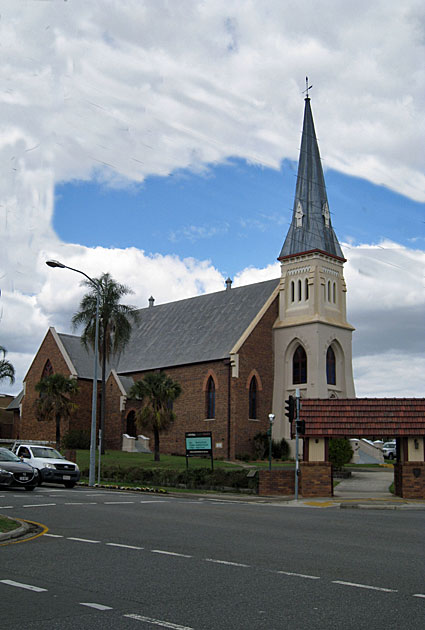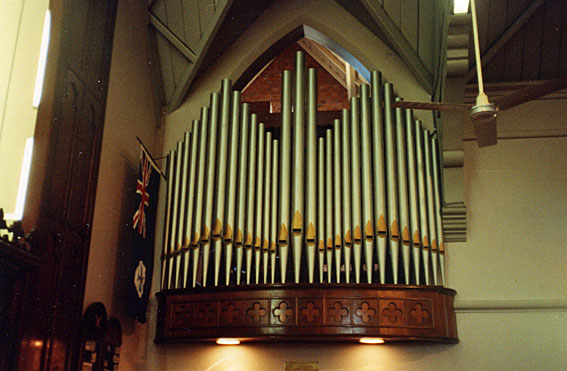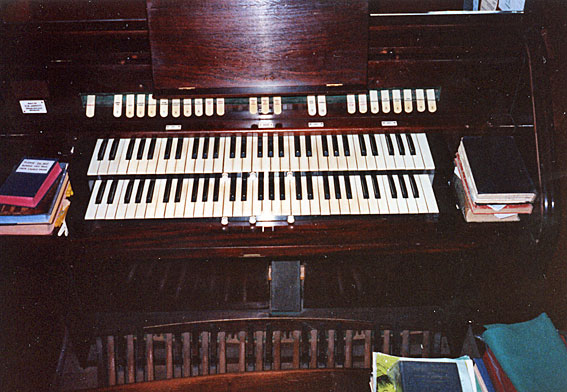
Central Presbyterian Church, Ipswich
[Photograph by Geoffrey Cox (September 2016)]

Central Presbyterian Church, Ipswich
[Photograph by Geoffrey Cox (September 2016)]
Historical and Technical Documentation by Geoffrey Cox
© OHTA 2011, 2016 (last updated September 2016)
The first Presbyterian service in Ipswich was conducted by Dr John Dunmore Lang in 1845 in the parlour of an inn. A congregation became established with the arrival of Dr W.L. Nelson in 1853, and a stone building was erected on the present site in 1855. It is recorded that a harmonium was used in public worship in the early 1860s and that a paid organist was engaged.1 Originally known as Scots Church, it became St Stephen's in 1862.2
The foundation stone of the present church was laid in August 1865, and the cost of the building was given as £3397 'without windows and organ.'3 Designed by the architect, Joseph Backhouse (brother of Benjamin Backhouse), the building was opened in 1866. Owing to problems in the foundations, it was virtually rebuilt in 1911-12, and enlarged with the addition of transepts in 1958.4 The name of the church was changed to 'Central Presbyterian Church' in 2008.
First Organ.
There is reference in the Presbyterian Magazine to a pipe organ being played 'so skillfully by a Mr John Blow' at the opening service of the new church on Sunday 8 April 1866,5 and a full account of the opening appeared also in The Queenslander as follows:
ST. STEPHENS PRESBYTERIAN CHURCH, IPSWICH.
THE new Presbyterian Church, Ipswich, was opened for Divine worship on Sunday last, by the Rev. W.L. Nelson, Moderator of the Queensland Church, who conducted the morning service, and read the dedication prayer, which was very beautiful and impressive. A very eloquent sermon was also delivered by the same gentleman, who chose for his text the 17th verse of the 14th chapter of St. Paul to the Romans - "For the kingdom of God is not meat and drink; but justice, and peace, and joy in the Holy Ghost." The organ was well played by Mr. Blow, and the singing excellent, and a very great improvement on what it was formerly. The evening services were conducted by the Rev. M. M'Gavin, who also preached a very impressive sermon from the last clause of the 7th verse of the 60th chapter of Isaiah -"And I will glorify the house of my glory." The church, when lighted up as it was on Sunday night by numerous lamps, presents a very imposing appearance. The music and singing in the evening was also very good. The place during both services was crowded, and we presume a very handsome collection was made. The new church has been built on the same grounds and partly over the same site on which the old church stood. When it was resolved that a new edifice should be erected, it was not long until the attire members of the church had inaugurated the necessary working committee; and after receiving designs from local and Brisbane architects, that of Mr. J. Backhouse, architect and town surveyor of Ipswich, was accepted. The style of the building is plain Gothic. It is built with freestone foundations and base; the walls of 18 inch brickwork, 21 feet high, and having Portland cement dressings to angles, openings, copings, and tower. The roof is open-timbered and slate-covered, the main timbers coming down with cut knees on to internal corbels. The interior is plastered in imitation of stone, and is lined 4 feet up the sides with cedar dado, plinth, and capping. The tower at the western end faces the town, the ground rising from it to the east end of the church. The base of the tower is nineteen feet square, on solid stone-work rising eight feet, surmounted with brick-work, in arched openings, carrying the organ-loft, above which is the belfry, in which is hung a bell - the largest and best-toned in Queensland - presented to the church by the Hon. A. Macalister. Above the brickwork of the tower, which is elevated some sixty feet from the ground, a graceful spire, lead-covered and with gilt vane finial, rises to a further height of sixty-two feet, making a total height of 122 feet. The vestry is at the east end of the building, opening into the main body of the church on either side of the pulpit. The approaches are by a flight of ten stone steps eight feet wide up to the tower entry, and there are similar steps to the two side porches. The fittings of the interior are of cedar throughout, the seats having solid Gothic headed ends and open backs. The lobby entry is formed with Gothic headed panel work and swing folding-doors, with ornamental perforated fan-lights; and over the lobby is constructed an organ-gallery, approached by a staircase in the body of the lobby. The gallery front is built with massive moulded and Gothic panel work and perforated spandrels; the front also having ornamental standards, rods, and curtains, above which rises the organ—a handsome instrument, in both strength and tone well adapted to the edifice.6
From the above account it can be ascertained that the organ was located in a loft above the lobby and beneath the belfry in the tower. Few other details of the instrument have survived, although it was reported to have been repaired around 1881 when a new choir gallery was built:
Ipswich [FROM OUR CORRESPONDENT]
The Presbyterian Church choir has greatly improved during the past six or eight months, chiefly as the result of the enthusiastic efforts of the leader, Mr. Donald McKay. Recently the organ has been repaired, and a new choir gallery built. To liquidate the expense connected therewith a most successful concert was given on Tuesday last. The work performed was W. L. Bradbury's sacred cantata "Esther." It included solos, duets, quartetts, and choruses, all more or less of moderate difficulty. . . . Mr. McKay conducted throughout, and Mr. J. J. Wells rendered material assistance at the organ. During the evening the Hallelujah Chorus was performed as a duet on the organ by Mr. Wells and Mr. J. Hockley (ex organist of St. Paul's, Church of England). This novelty was worth the hearing.7
This instrument was still at St Stephen's in 1902, when consideration was given to installing hydraulic blowing,8 and it possibly remained until it was replaced by the present organ (see below). The fate of the first organ has remained unclear, but it is possible that it was the one installed around 1921-22 at the Southport School, subsequently located at St Peter's Anglican Church, Southport, which was once rumoured (implausibly) to have come from St Mary's Catholic Church, Ipswich.
Present Organ.
The present organ was built originally by B.B. Whitehouse & Co of Brisbane. It was opened and dedicated on 9 December 1917,9 and stood originally beneath the giant rose window on the eastern wall as a memorial to the Rev Peter Robertson, who was Minister of the church from 1877 to 1916.10 A photograph of the original organ (now in poor condition) reveals that the configuration of the façade pipes has been retained on the present instrument.11 An electric blower was installed in 1923.12

The present façade pipes of the organ,
retaining the original 1917 configuration
[Photograph by Howard Baker (1990s)]
This was the last mechanical-action instrument built by the Whitehouse firm, who had already commenced using pneumatic action around a decade earlier. It had the potential to exceed in size their instrument for St Mary's Catholic Church, Maryborough (1912), but the St Stephen's instrument was never completed according to the envisaged plan. There was provision for several stops to be added on the existing two manuals, and the console included a third manual. The soundboard and action for the Choir division, however, were never provided:
| GREAT Open Diapason Dulciana Stopped Diapason Clarabella Lieblich Flute Fifteenth [& 4 spare stop knobs] SWELL Open Diapason Lieblich Gedact Salicional Voix Celeste Gemshorn Harmonic Piccolo Oboe [& 4 spare stop knobs] CHOIR [prepared for at console only] [4 spare stop knobs] PEDAL Bourdon [& 2 spare stop knobs] COUPLERS Swell to Great Great to Pedals Swell to Pedals Choir to Pedal [prepared] Swell to Choir [prepared] 'Great to Pedal Off' |
8 8 8 4 2 8 8 8 8 4 2 8 16 |
Tremulant
Attached draw-stop console (3 manuals)
Pedalboard: parallel
Hitchdown lever swell
4 combination pedals to Great Organ
3 combination pedals to Swell Organ
Mechanical action
Compass: 56/30.13

The Whitehouse organ installed in the new organ loft
by H.W. Jarrott in 1958
[Photograph by Howard Baker (1990s)]
Following enlargement of the church, the organ was rebuilt with electric action in 1958 by H.W. Jarrott, and installed in its present location, an organ loft in one of the new transepts. Three stops were added at this time: Swell Cornopean 8ft, Great Principal 4ft and Pedal Bass Flute 8ft, the latter two by extension. The original slider chest was retained on the Swell, with electro-pneumatic action, while the Great was converted to direct electric action. A new detached stop-key console was provided and the compass was extended to 61 notes.14

The detached console provided by H.W. Jarrott in 1958
[Photograph by Howard Baker (early 1990s)]
The organ was most recently rebuilt and enlarged in 1996 by Ian D. Brown and Associates, Ballina. The original Swell soundboard was retained, but a new 8-stop slider chest was provided for the Great Organ.15 Along with the provision of several new ranks, and some judicious extension and borrowing of existing ranks, all original ranks were retained. A few of these were adapted as follows: The original Open Diapason 8ft on the Great (which Jarrott had extended to provide a Principal 4ft) was retained on the Great only as the Principal 4ft, and the original Fifteenth 2ft was re-named Piccolo 2ft. A larger scale second-hand Bourdon 16ft (from the Anglican Church in Young, New South Wales) was provided for the Pedal, and the existing Bourdon 16ft was re-named Echo Bourdon 16ft.
The resulting specification is as follows:
| GREAT Lieblich Double Open Diapason Dulciana Stopped Diapason Principal Flute Fifteenth Piccolo Mixture Swell Cornopean SWELL Violin Diapason Lieblich Gedackt Salicional Vox Celeste Gemshorn Piccolo Contra Cornopean Cornopean Oboe Clarion PEDAL Bourdon Echo Bourdon Principal Bass Flute Contra Cornopean COUPLERS Swell to Great Great to Pedal Swell to Pedal Swell to Great Super Octave Swell to Great Sub Octave Swell Super Octave Swell Sub Octave Swell to Great Ped comb [sic.] |
16 8 8 8 4 4 2 2 III 8 8 8 8 8 4 2 16 8 8 4 16 16 8 8 16 |
A B B B B A A B |
[1996] [1996] [formerly Open Diapason 8ft] [1996] [formerly Fifteenth 2ft] [1996] [1996] [1996] [1958] [1996] [1996; from Anglican Church, Young, NSW (c.1900?)] [formerly Bourdon 16ft] [1996; facade pipes (original Open Diapason?)] [1958] [1996] |
Tremulant
Detached stop-key console
Pedalboard: radiating concave
Balanced swell pedal
5 thumb pistons to Swell Organ
5 thumb pistons to Great Organ
5 thumb pistons to Pedal Organ
8 General thumb pistons
64 channel capture system
Electro-pneumatic action
Compass: 61/30.16
The windchest of the Echo Bourdon 16ft sustained some storm water damage late in 1999, following the breaking of a window at the rear of the organ chamber. The damage was repaired in March 2000.17
____________________________________________________________
1 Richard Bardon, The Centenary History of the Presbyterian Church of Queensland (Brisbane: W. R. Smith & Paterson, 1949), pp. 233-34. [Lang's visit is dated December 1844 in other sources].
2 Queensland Heritage Council, Queensland Heritage Register, location 600580.
3 Bardon, p. 234.
4 Queensland Heritage Council, Queensland Heritage Register, location 600580.
5 Presbyterian Magazine (May 1866), cited in Thomas Appleton, 'The Organ at St. Stephen's Presbyterian Church, Ipswich, Queensland,' The Organ Voice, vol. 23, no. 1 (March 1997), pp. 12-23.
6 The Queenslander (14 April 1866), p. 7.
7 The Brisbane Courier (14 October 1881), p. 3.
8 Church records, cited in Appleton (1997), p. 14.
9 The Queensland Times (10 December 1917), p. 4; The Whitehouse Bros list gives the date as 1915, which presumably refers to the signing of the contract.
10 Appleton (1997), p. 14.
11 Appleton (1997), p. 15
12 'The Presbyterian Church: A Link with the Pioneers,' The Queensland Times (3 November 1923), p. 6.
13 Collected Organ Specifications of Bernie Brohan (c.1952).
14 Personal communication from H.W. Jarrott to G. Cox, 1973; Specification noted by G. Cox, 1973.
15 The Sydney Organ Journal, vol. 27, no. 2 (Winter 1996), p. 21.
16 Specification from Appleton (1997), p. 21 and Thomas Appleton, 'The Pipe Organs of Central Ipswich - Part 2,' The Organ Voice, vol. 25, no. 2 (June 1999), pp. 9-10.
17 The Organ Voice, vol. 26, no. 3 (Sept. 2000), pp. 25-26; The Sydney Organ Journal, vol. 31, no. 3 (Winter 2000), p. 22.